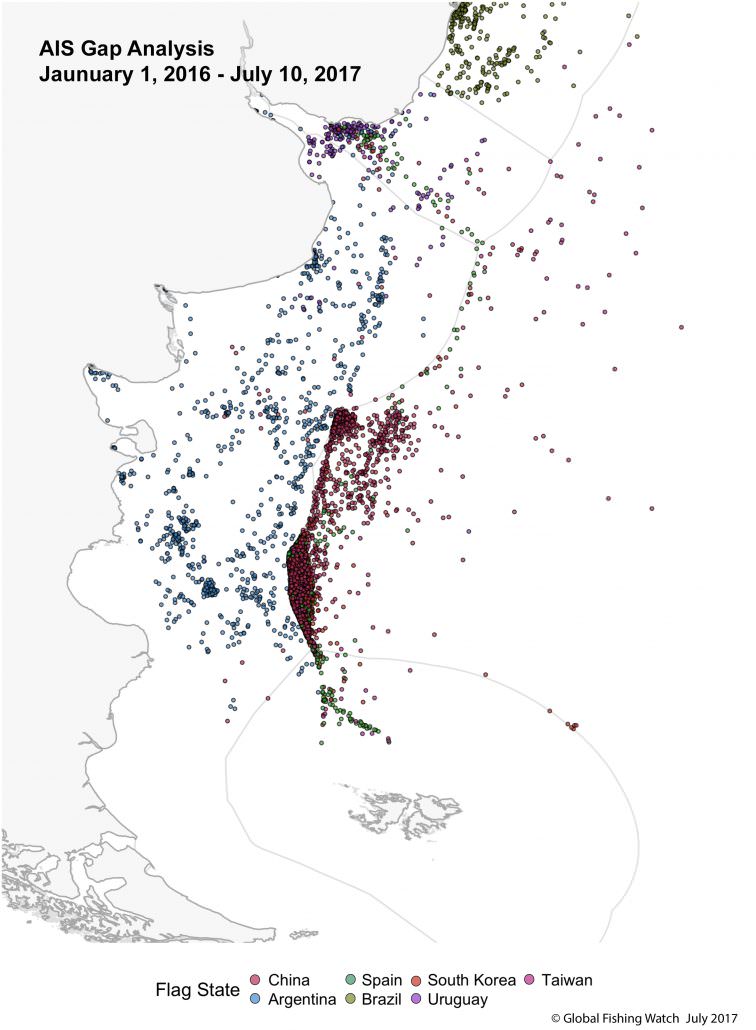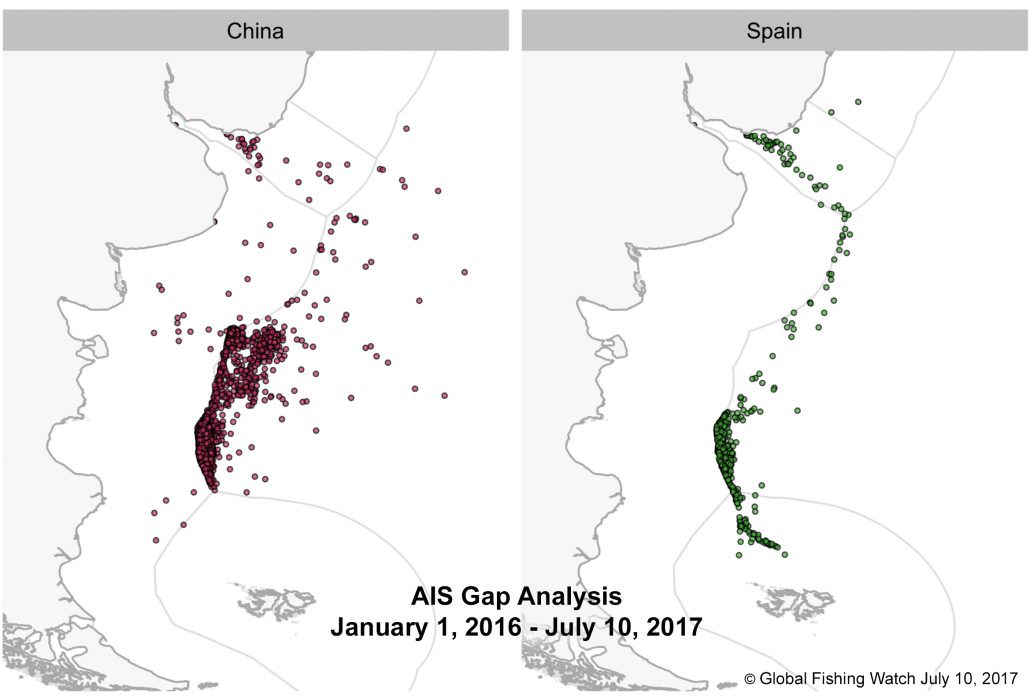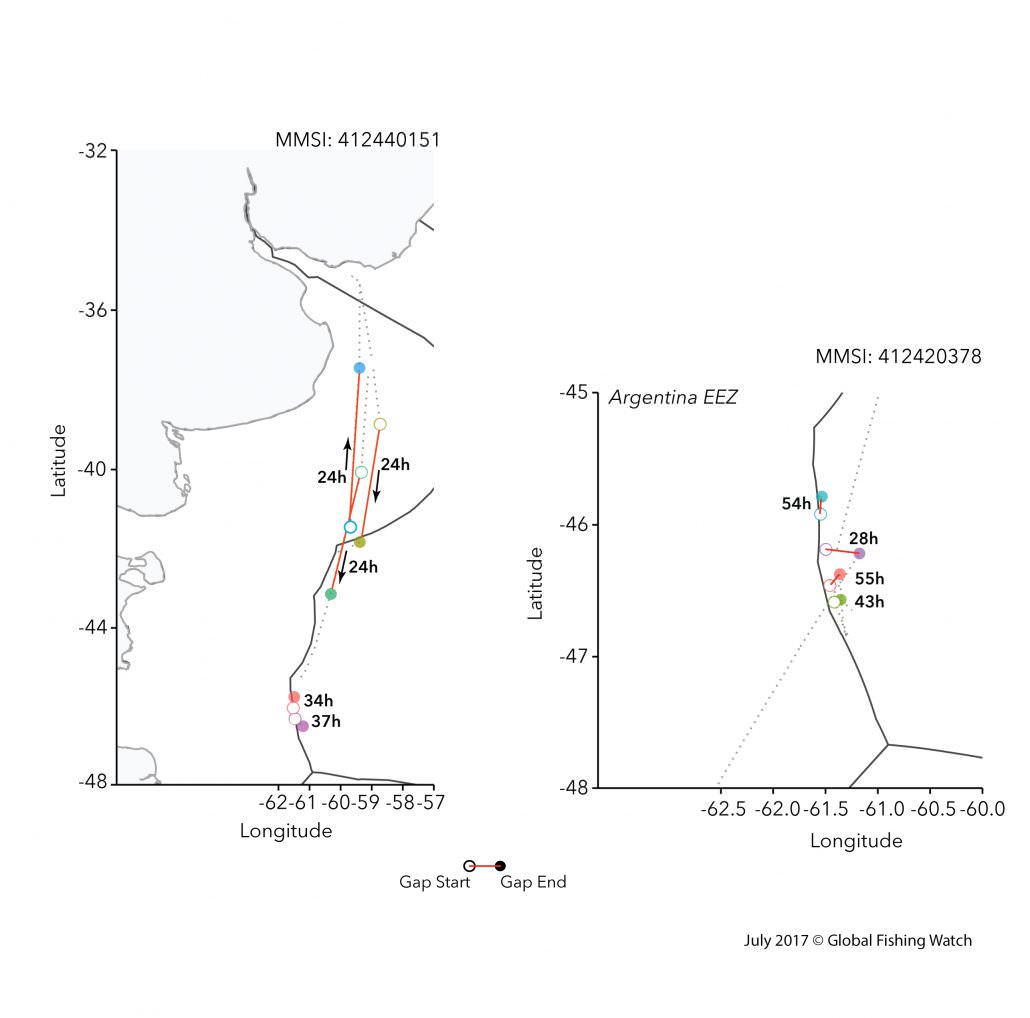
We are often asked about how Global Fishing Watch can be effective when vessel captains can simply turn off their AIS. And our answer has always been, “they have to turn it back on sometime—especially when entering port, and intentional blackouts raise a red flag.” Our recent analysis of fleet activity around the Argentine EEZ is a prime example of how careful analysis allows us to “read between the lines” and quite literally begin to fill in the gaps.
Our analyst, Nate Miller, has been looking closely at gaps in AIS signals along the border of the Argentinian Exclusive Economic Zone (EEZ), an area associated with a large Patagonian Shortfin Squid fishery. He’s found that not only do gaps cluster in distinct patterns along the EEZ border, but they overlap with hotspots of potential transshipments.
Transshipment is the practice of transferring goods between vessels. In the fishing industry, large refrigerated cargo ships—called “reefers”– gather catch from multiple fishing vessels for delivery to port. It’s a practice that facilitates the mixing of legal and illegal catch as well as human rights abuses because it enables fishing vessels to remain at sea for many months at a time.
Within Argentine waters, transshipment is prohibited, and the squid fishery is tightly regulated. For the past three seasons, no foreign vessels have been issued permits to fish for squid inside the Argentine EEZ. Just over the line, however, in the high seas, not only is the squid fishery unregulated, but transshipment remains legal.
That’s why suspicious activity among squid fishing fleets in this area can raise a lot of questions. “We see that AIS data from fishing vessels around Argentine waters is very gappy,” Nate says, “and we know there are gaps in the data around Transshipment also. We can’t say what it means, but we’re trying to figure out what we can see so that then others can maybe take it further and find out more about what’s going on.”
First, let’s deal with the gaps in AIS signals from fishing vessels.
To rule out some of the many reasons AIS signals can drop out (ie: gaps in satellite coverage or signal interference in crowded areas), Nate considered signal gaps that lasted 24 hours or longer from January 1, 2016 to July 10, 2017.

[See these gaps broken out by country]
The data shows that gaps inside the EEZ occur randomly and are mostly from Argentine vessels. Outside the EEZ, things get more interesting. Four fleets fishing off Argentina exhibit a significant number of AIS gaps in distinct patterns right along the boundary of the EEZ. (Chinese, Spanish, South Korean, Chinese Taipei). The largest number of gaps occurs among the two largest distant-water fleets in the world; Spanish and Chinese.
Fishing Vessel gaps and Hotspots for Transshipment
In our report “The Global View of Transshipment,” we traced five years’ worth of AIS data from refrigerated cargo vessels around the world, matching their behavior with that of reefers engaged in verified transshipments. When a reefer exhibited transshipment-like activity—meeting with a fishing vessel and traveling slowly enough for long enough to have transferred catch—we labeled the event a “likely transshipment.” When we observed a reefer exhibiting the same behavior in the absence of AIS signals from a fishing vessel, we assumed the possibility that a fishing vessel was present but turned off its AIS. We labeled these events “potential transshipments.”
The data revealed that the border of Argentina’s EEZ is a hotspot for likely and potential transshipment. Since publishing that report, Nate decided to revisit the data to see if reefers are also turning off their AIS. “Globally, gaps in reefer signals are not very common,” he said, “So it doesn’t surprise me that there are not very many here around Argentina. But where we do see reefers with gaps in AIS coverage of more than 24 hours is exactly the same place where our data shows likely transshipments with fishing vessels.”
![In the images above, we see three primary pockets of likely transshipment (when a fishing vessel has an encounter with a reefer) [Left]. Two just outside the Argentine EEZ where we see AIS gaps for both Spanish and Chinese vessels (as well as Taiwanese and South Korean) and one within the Malvinas EEZ where we only see Spanish vessels. On the right, we see gaps in reefer coverage of more than 24 hours.](https://globalfishingwatch.org/wp-content/uploads/2017/07/transshipment_vessel_events_2016_2017-01-1030x934.jpg)
Patterns of Gaps Differ Between Fleets
The data show that the different fleets “go dark” in different places and exhibit distinct patterns of behavior.

Compared to the Chinese vessels, the Spanish fleet shows a higher proportion of gaps all along the Argentine EEZ south toward the Falkland Islands (islas Malvinas) and north along the boundary with Uruguay. If we assume transshipment is occurring within AIS gaps, the difference between fleets may indicate that the Spanish are transshipping more than the Chinese.
But geopolitical concerns complicate the story. There are territory disputes between Spain and Argentina over fishing grounds, so it’s possible that Spanish vessel captains turn off their AIS more frequently on their way into port in Uruguay to avoid confrontation by the Argentinian Coast Guard.
In the case of the Chinese, clustering of gaps along the border is less distinct, which, could mean a few things depending on how you look at it. It could just be that Chinese captains turn off their AIS well before they cross through the Argentinian EEZ on their way to port—maybe to avoid harassment by the Argentinians who have accused them of sneaking over their border to poach fish. On the other hand, it may indicate Chinese fishing vessels go to port less frequently. That would likely mean they are transshipping frequently so that vessels can stay on the fishing grounds longer.
“We’re seeing these patterns, and we don’t know what they mean,” Nate says. “There could be multiple reasons for what the data shows us. But it’s clear the two fleets are behaving differently in this area.”
Corroborating Evidence in the Data
Despite the complicated international relations, the overlap between AIS black-outs and likely transshipment events makes a strong case for further investigation. In the image below, you can see that a large number of Chinese fishing vessels turn off AIS (points on the map represent 3553 gaps) in the same area where we see 181 likely transshipments involving Chinese vessels.
Spanish vessels are seen engaged in just one likely transshipment but a considerable number of Spanish vessels go dark in the same area. Perhaps the Spanish are transshipping just as much as the Chinese, but they’re doing it entirely within AIS gaps, so we are unable to detect them.
“The Chinese and Spanish vessels clearly are behaving in very different ways in this region,” Nate says. “We can’t say why, but it brings up questions as to what they are doing, and what the data represent.”
Another Pattern of Gaps Inside the EEZ
Two patterns also seem to be emerging among Chinese fishing vessels inside the Argentine EEZ. Long gaps in AIS signals that begin well within the southern portion of the EEZ reappear farther to the north as vessels exit the EEZ. “Based on where they were before and after they turn off AIS, it looks like these are mostly vessels circumnavigating Cape Horn on their way to or from Peruvian fishing grounds,” Nate says. It looks as if they may simply be transiting through, possibly turning off AIS as they approach the EEZ boundary from the inside to avoid trouble with the Argentine coast guard as they leave Argentine waters.
The second pattern has yet to be explored, and may be more intriguing. “There is a set of gaps that begin very near the EEZ boundary,” Nate says. “These are of considerable interest because Argentine fishermen and officials regularly claim that the Chinese vessels turn off AIS and sneak across the EEZ boundary to fish.” In these cases, a vessel tends to go dark near the EEZ and reappear relatively nearby more than 24 hours later.

That these vessels travel such short distances between extended periods with their AIS turned off begs the question: what are they doing during the time we can’t see them?
That’s a question we can ask about any one of the long gaps in AIS signals received from ships at sea. In the area around Argentina alone, there are 8,320 that last more than 24 hours—way too many to investigate one vessel at a time.
Nate’s gap analysis enables a whole new approach. By interpreting patterns in the data, his work is demonstrating that, sometimes, radio silence may be almost as telling as signals that come in loud and clear.